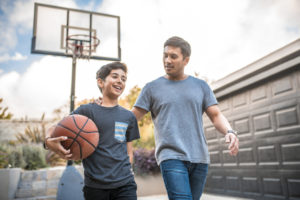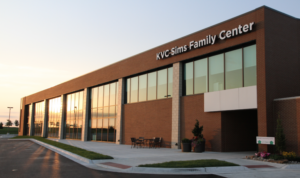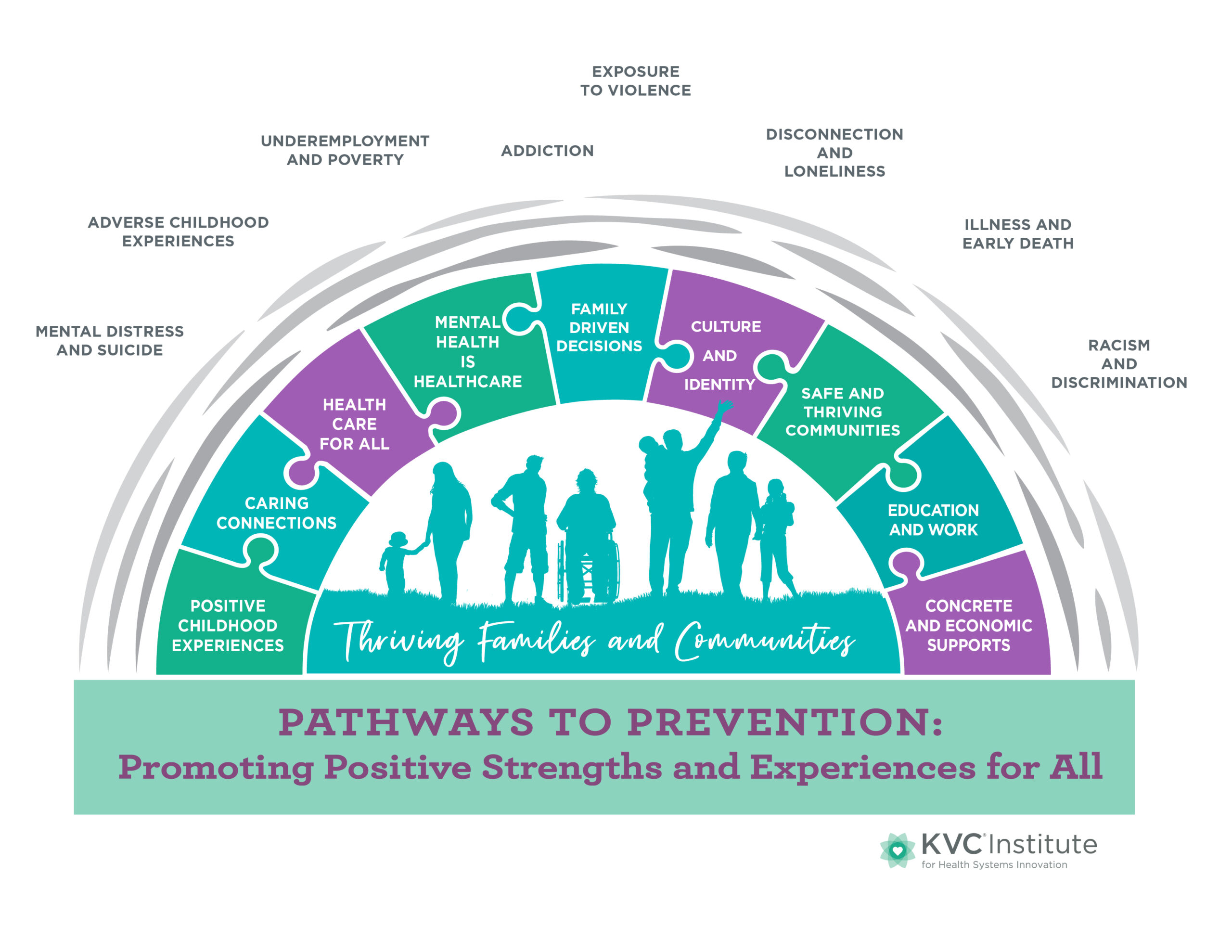From Risk to Resilience: KVC’s Pathways to Prevention

One of the most important parts of our work at KVC is prevention. It’s our goal to provide resources and connections early on. Ultimately, it’s our mission to improve child and family wellness through all of our programs and services. At the crux of everything we do is research and training grounded in trauma-informed care and strengthening our prevention approaches.
Prevention efforts today can minimize the need for crisis services tomorrow. Below, we’ll explore what prevention means to KVC, and how this can result in positive ripple effects.
Pathways to Prevention: Promoting Positive Family Assets and Experiences
The KVC Institute for Health System Innovations is dedicated to training, consultation and research. Dr. Suzanne Lohrbach, Executive Director of the KVC Institute, explains that the Institute has been very focused on prevention recently, specifically in terms of how to define what prevention means.
The KVC Institute has developed a Pathways to Prevention infographic that visualizes how certain protective factors wrap around a family and create a preventative buffer against adverse consequences such as:
- Mental illness and suicide
- Divestments in education and opportunities
- Violence
- Disconnection and loneliness
- Disparities in healthcare and healthcare access
- Racism and discrimination
The KVC Institute worked with individuals, families and communities to canvas the research and literature around what supports thriving families. These nine protective factors, represented in the graphic by puzzle pieces, act as a shield against threats to individual and familial health and development. “What we’re working to prevent is all of the outside negativity or adverse consequences that tend to be prevalent without a really intentional focus on what it is we do,” says Lohrbach.
How KVC Defines Each Protective Factor
The nine protective factors are vital pieces of the puzzle for building thriving families. “We want to ensure that our service delivery, practice, interventions and interactions are all centered on promoting these areas and strengthening where they may be present but could be more powerful,” explains Lohrbach.
The infographic represents an ideal where all of these protective factors are present. Though we recognize this is a work in progress for every family, individual and even for our KVC service providers.
Positive Childhood Experiences
 Positive childhood experiences (PCEs) are valuable tools for preventing childhood trauma. PCEs can either prevent adverse childhood experiences or help strengthen resilience in children and families to work through trauma as it arises. Dr. Christina Bethell identified seven key PCEs in a 2019 study:
Positive childhood experiences (PCEs) are valuable tools for preventing childhood trauma. PCEs can either prevent adverse childhood experiences or help strengthen resilience in children and families to work through trauma as it arises. Dr. Christina Bethell identified seven key PCEs in a 2019 study:
- The ability to talk with family about feelings
- The sense that family is supportive during difficult times
- The enjoyment of participation in community traditions
- Feeling a sense of belonging in high school
- Feeling supported by friends
- Having at least two non-parent adults who genuinely cared
- And feeling safe and protected by an adult in the home.
These PCEs can be the difference between a thriving family and a child struggling to get their head above water amid trauma. “These are all weighty protective factors that begin to tip the balance to respond and build some remedies around risk factors,” says Lohrbach.
Connections
Connections build resilience. “If a child has an enduring connection with another caring, competent adult outside the primary caregivers in their lives,” explains Lohrbach, “that really can see them through some of the turbulence of life.” These caring connections may be relatives like an aunt or grandparent but often come from the surrounding community. Many individuals can invest time and care into a child or teen — teachers, coaches, youth leaders, family friends and more!
Health Equity
These puzzle pieces are two sides of the same coin. But they are also both important enough to require separate pieces in the infographic. Health equity is essential to ensuring that every person has access to the healthcare they need, whether that be physical, mental or emotional. “We want to strive to make holistic ways of healing the body available to everyone,” says Lohrbach.
Mental Health Parity
In addition to accessibility, mental health care must be seen as health care. Just as a person knows they should see a doctor if they break their arm, so too should seeing a therapist or psychiatrist be standard practice when dealing with some form of mental or emotional distress.
Family-Driven Decisions
It is our responsibility as service providers to make sure individuals and families have access to all the information they need to make an informed decision about care. Lohrbach emphasizes that this is about more than just engaging service recipients in the planning, assessment and decisions around patient care and actually involving them in every step of the process, giving them “a seat at the table or within the circle around matters that affect them.”
With every decision made, whether that be for a child’s behavioral health care, navigating child welfare situations or seeking assistance for the individual self, the decision should be an informed one that puts the power in the hands of the person and the family.
Culture & Identity
Culture is one of our key tenets at KVC for a reason! Every person has a right to their cultural practices, traditions and knowledge that give them a sense of identity and history. When a person’s identity and culture are valued, they are better prepared to succeed and thrive. It’s crucial that components of who they are don’t get shoved aside. This directly informs the person-first care we provide at KVC. “To be truly curious and respect and exchange is a matter of how you sit in a space and share time with someone,” she says.
 Community Prosperity
Community Prosperity
Non-medical factors within a community can have a significant effect on health outcomes for the individuals and families that make up that environment. Safe and thriving communities rely on everyone working together. Being intentional about defining safety and finding practical applications within the neighborhood or community. This protective factor relies heavily on the community itself to wrap around families and create a sense of safety and belonging.
Opportunities to Learn & Earn
Learning and earning—education and, later in life, work—are how we make meaning in our lives. Lohrbach breaks down the value behind these two opportunities and how they relate to an individual’s sense of self and value. “Learning is part of using one’s whole self. It’s about connecting with others and developing a pathway for building out your best contributions. Work becomes the means to feed, clothe, recreate, connect, survive and thrive.” Access to a good education and meaningful job opportunities can improve mental health and self-esteem, decreasing risk factors for mental illness.
Concrete & Economic Supports
There is a clear correlation between insufficient resources to meet basic needs and negative wellness outcomes. Housing instability, unemployment and economic instability are significant predictors of child welfare or other system involvement. Concrete and economic supports are about getting ahead of these resource-based struggles. Working to help communities build support and provisions for struggling families.
 How KVC Hopes to Utilize Pathways to Prevention
How KVC Hopes to Utilize Pathways to Prevention
While this infographic is new, we have high hopes for how it will impact the work we do throughout KVC. This is more than just a helpful tool—it supports KVC service providers both institutionally and individually to think about prevention across the entire continuum of service.
The next step is to bring this concept into practice throughout KVC, taking the information and turning it into practical applications that support the children, individuals and families in our care. The biggest impact we expect to see is with interactions between service providers and service recipients.
“Sometimes, it’s just one interaction or one moment with a child or an adult that sticks for them,” says Lohrbach. “So we want to be disciplined and mindful and intentional that every interaction is actually an intervention.”
The concepts within this infographic are already present in KVC’s overarching practice model, known as the Safe and Connected™ Practice Model. The introduction of this infographic takes all of that research and focuses it outward, building from the individual, the family and the community to create even greater protection against negative outcomes.
What This Means for Families and Communities
When looking at the nine protective factors and considering how many of them are outside of individual control, it can feel like an impossible task. Lohrbach pushes back on this mentality, encouraging everyone to trust that it is possible. “It’s doable for everyone to thrive within our communities,” she says. “What it requires is folks leaning in and pulling in the same direction with that same basic value of thriving and connection at play.”
It may feel like you’re just one person, but your voice can make a difference. For those interested in getting involved and helping make these protective factors the standard in their communities, Lohrbach encourages them to support legislation that will strengthen these areas on a local, state and national level. You can also support KVC’s efforts by donating or becoming part of the KVC team in your area!








